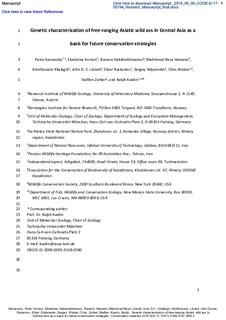Genetic characterization of free-ranging Asiatic wild ass in Central Asia as a basis for future conservation strategies
Kaczensky, Petra; Kovtun, Ekaterina; Habibrakhmanov, Rustam; Hemami, Mahmoud‑Reza; Khaleghi, Amirhossein; Linnell, John Durrus; Rustamov, Eldar; Sklyarenko, Sergey; Walzer, Chris; Zuther, Steffen; Kuehn, Ralph
Journal article, Peer reviewed
Accepted version

Åpne
Permanent lenke
http://hdl.handle.net/11250/2560954Utgivelsesdato
2018Metadata
Vis full innførselSamlinger
- Publikasjoner fra CRIStin - NINA [2397]
- Scientific publications [1423]
Originalversjon
10.1007/s10592-018-1086-3Sammendrag
Loss of genetic diversity due to drift and inbreeding reduces a population’s ability to respond to environmental change and may result in inbreeding depression. The Asiatic wild ass (Equus hemionus), regionally also known as Gobi khulan, Turkmen kulan, or Persian onager, has become confined to less than 3% of its historic distribution range. Remaining populations in Central Asia outside of the Mongolian Gobi are small and fragmented. Questions concerning subpopulation status remain disputed and concerns over the viability of these populations have been raised because of small size, past bottlenecks, or recent founder events. We used non-invasive faecal samples to assess the genetic diversity and divergence among Turkmen kulan and Persian onager from five free-ranging and one captive population from Turkmenistan, Kazakhstan and Iran and compared their genetic constitution to the large autochthonous population in the Mongolian Gobi. We observed loss of genetic diversity (drift and inbreeding) in the captive and reintroduced populations as well as in one rapidly declining
autochthonous population. Population differentiation and structure using microsatellites and mtDNA based phylogenetic analysis do not support the current separation of the autochthonous populations of Turkmen kulan and Persian onager into different subspecies, but rather suggest a cline with the Iranian population in Bahram-e-Goor at the southern end and the Turkmen population in Badhyz at the northern end falling into two distinct clusters, and the northern Iranian population in Touran being intermediate. We compare our findings to other population genetics studies of equids and discuss the implications
of our findings for the future conservation of the Asiatic wild ass in the region.